A few weeks ago, I gave a brief talk at the workshop “Asian Papers” at Dartmouth College, organized in part by my colleague and co-Mellon Fellow in Critical Bibliography, Holly Shaffer. The workshop was a welcome opportunity to start organizing some of my thoughts on the difficulty of applying Western descriptive bibliographic standards to the bibliography of the East Asian book. In line with the workshop topic, my presentation focused on the sorts of bibliographic information available from a close examination of paper.
One of the major bibliographic differences between European and East Asian paper in the early modern period is the presence of watermarks in the former. Watermarks are present in most pre-modern western paper. The earliest recorded reference to watermarks comes from the Perugia based jurist Bartolo da Sassoferrato (1314-57). He wrote:
Here there are many paper mills, and some of them produce better paper, although even here the skill of the worker is of considerable importance. And here each sheet of paper has its own watermark by which one can recognize the paper mill. Therefore, in this case the watermark should belong to the one to whom the mills itself belongs, no matter whether it remains in his possession by right of ownership or lease, or by any other title, wholly or in part, or even in bad faith. During the entire time in which he has possession of the mill, he cannot be prohibited from using the watermark…(source)
According to Sassoferrato, these watermarks allowed mills to trademark their products.
The production of watermarks is a simple process. Essentially, every piece of hand-made paper is marked with an impression of the screen which removed its wet pulp from water. Early European watermarks came from wire designs tied onto wire screens. When the screen, with the deckle on top, was dipped into a vat of pulp, the resulting paper would have the impression of both the screen wires and the design. I had a chance to see this process last year, when visiting the last wind-powered paper mill in the Netherlands, De Schoolmeester in Westzaan. (The field-trip was part of a great conference organized by Megan Williams at the University of Groningen)
While watermarks can be appreciated for their aesthetic appeal alone, they have also proven to be indispensable tools for bibliographers. Since each mill had its own watermarks, and since wires break and need to be repaired, careful analysis of watermarks has allowed bibliographers to narrow down the dates of editions, decide where something was printed, and observe other sorts of oddities that occur as paper moves through the printing press.
Scholars of the East Asian book don’t have anything quite like watermarks. In our field of bibliography, paper is rarely considered at all. When it is considered, people usually say something like printed on “rice paper.” The reason paper is so difficult for East Asian bibliographers is because it is incredibly varied.
Unlike in the West, premodern East Asian papers were made entirely from raw plant materials (rather than recycled rags). East Asian paper production was therefore agrarian. Farmer-papermakers made paper to supplement household income during periods of agricultural quiet, although some regions produced year-round. In terms of material composition, it is almost impossible to speak of a “typical” paper. Chinese papers were highly local products, relying on plants endemic to the region of production. According to the Tiangong Kaiwu, a late Ming technological manual, to make paper from bamboo, young bamboo was harvested, cut into small sections, and soaked for several months in either a pool or running water. After soaking for roughly three months, the bamboo was ready to be processed by “killing its green.” The phrase means that the husks of the plant were removed, and the fibers left over were then combined with lime and then either left to soak for up to a month or boiled for seven to eight days. Both methods weakened the long fibers so that they could be processed more efficiently.
Once the first boiling or month-long soaking was done, the strands of bamboo were washed in clean water. The fibers were then recombined with ash, boiled, and strained, in an almost continual cycle for ten days. In some places, such as Jiangxi province, they were also left to bleach in the sun, sometimes for months. When the fibers had “ripened,” they were drained and pupled by wooden beaters until they had a clay-like consistency. The pulped paper would then have some form of sizing added (every region had its own preference), and only then was the mess transferred to a vat. Once in the vat, a vat man would use a bamboo screen to pull individual sheets of paper. As with European paper, the paper sheets would be couched in piles and pressed to remove moisture. In the final stage of drying, the paper would be brushed onto a wall for drying. A team of four, working the screens, couching, and drying could produce over sixty pounds of (probably more than two thousand) sheets a day. After paper was dried, it would be assembled into bundles for transport to the market. It was at this time that the Chinese version of a “watermark” would be added, with an inked stamp noting its manufacturer’s name.
The description of production above stems from the Ming dynasty (1368–1644), when Chinese papers were already common and inexpensive. In the earlier Song period (960–1279) paper was still scarce enough as to be frequently recycled, and few printed books from this period survive as a result. But in the fifteenth and sixteenth centuries paper became much cheaper and more widely available. Cheap paper meant that books, in both manuscript and print (by woodblock), were inexpensive in East Asia from a relatively early period
It wasn’t until a few years ago, when reading a wonderful blog post from the BL by Annabel Gallop, entitled “Malay manuscripts on Chinese paper,” that I even realized Chinese paper-makers stamped their paper.
(Seals of a Chinese supplier of paper, in a Javanese manuscript of Panji Angreni. British Library, MSS Jav 17, f.10v.)
Last year, while examining books in Japan, I found this:
After looking through many more books printed between 1550 and 1720, I noticed that longer books, those usually over two hundred pages, almost always have similar slivers of stamps. Who can even guess how many of these I’ve failed to ‘see’? The digitized books at the Harvard-Yenching Library have proved to be great sources for partial stamps. After seeing these stamps in so many places, I’ve belatedly started to collect them. I’ve also written to friends to let them know I’m on the prowl. One of them, Guillermo Ruiz-Stovel, Ph.D. candidate, UCLA, sent me several photos he took of materials in the Philippines.
Here is one nice example:
(1798. NAP, 6208 Aduana, f. 384v, photo graciously shared by Guillermo Ruiz-Stovel, Ph.D. candidate, UCLA)
The top stamp on the page shows that Chinese paper stamps were, like their European counterparts, part of paper firm’s attempts to control their brand. It reads:
“Recently there have been shameless sorts who have faked our branding of the “Double Children Seal.” All our patrons must remember that Changfa studios are the official distributors.”
In any case, between fragments and occasionally complete stamps, it seems that Chinese books actually do have something analogous to watermarks. They’re far rarer, they’re almost never complete, but they do exist. That means that we have to 1) collect examples from books that have stamps to see if they tell us anything (I’m certain they will), and 2) work them into bibliography.
So, if you see these, save them. Better yet, send them to me. I’ll work on raising money to get these things into some sort of database.
Note:
A few minutes after sharing this post, the wonderful Emily Mokros, University of Kentucky, wrote me about the research of Chang Pao-san 張寶三 from National Taiwan University. He seems to have done quite a bit of work on these stamps.
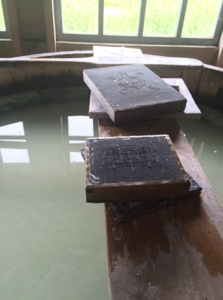
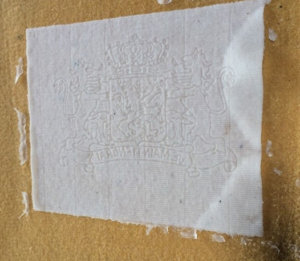
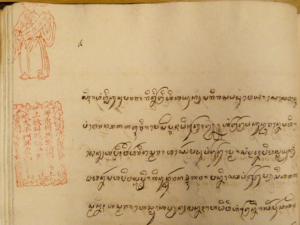
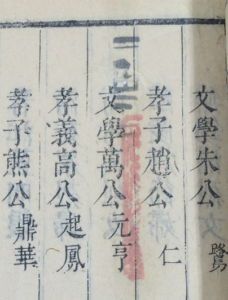
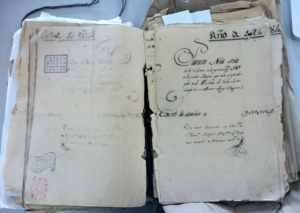


This one is probably already on your list but, just in case, there is a blue (sometimes blue and red) mark running through the Manchu copy of the Jin Ping Mei stored at the Documentation and Information Center for Chinese Studies, Kyoto University.